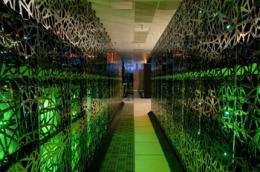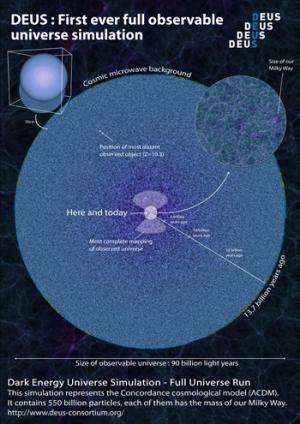First-ever model simulation of the structuring of the observable universe

A team of researchers from the Laboratoire Univers et Theorie (France) coordinated by Jean-Michel Alimi has performed the first-ever computer model simulation of the structuring of the entire observable universe, from the Big Bang to the present day.
The simulation has made it possible to follow the evolution of 550 billion particles. This is the first of three runs which are part of an exceptional project called Deus: full universe run, carried out using GENCI’s new supercomputer CURIE at the CEA's Très Grand Centre de Calcul (TGCC). This simulation, along with the two additional runs expected by late May 2012, will provide outstanding support for future projects dedicated to the observation and mapping of the universe. These simulations will shed light on the nature of dark energy and its effects on cosmic structure formation, and hence on the distribution of dark matter and galaxies in the universe.
After several years' research, six scientists of the cosmology group at LUTH have performed the first-ever computer model simulation of the structuring of the entire observable universe, from the Big Bang to the present day. This first simulation of the standard model of the universe with a cosmological constant will be followed by two additional runs focusing on the cosmological evolution of models with dark energy, the mysterious component introduced to account for the accelerated expansion of the universe. What imprint does dark energy leave on cosmic structures? And inversely, how can the nature of dark energy be inferred from observing the distribution of matter in the universe? These are two fundamental questions that the project Deus : full universe run will seek to answer.

Simulation of the standard cosmological model has already allowed researchers to discover a number of important properties concerning the distribution of matter in the universe. As an example, they have succeeded in estimating the total number of galaxy clusters with a mass larger than a hundred thousand billion solar masses. These clusters currently amount to 144 millions. The researchers have found that the first galaxy cluster of this type formed when the universe was only 2 billion years old and the most massive cluster in the observable universe today weighs 15 quadrillion (or 15 thousand trillion) solar masses. The data generated by the run has also allowed the scientists to evaluate spatial distribution of dark matter density fluctuations in the universe. These fluctuations have the same origin as those found in the Cosmic Microwave Background radiation, resulting from the Big-Bang and observed by the WMAP and Planck satellites. These measurements were obtained in a simulation covering the entire evolutionary history of the universe with previously unattained precision and on a much wider range of scales, from a few millionths to the size of the entire observable universe. This also revealed with unprecedented accuracy the imprint of the primordial plasma's acoustic oscillations on the distribution of dark matter (“Baryon Acoustic Oscillations”). This simulation already seems like a gold mine of new results for the cosmology community.
The implementation of this exceptional project would not have been possible without the powerful resources made available to the researchers by the Grand Equipement National de Calcul Intensif (GENCI), whose new supercomputer CURIE is equipped with more than 92,000 CPUs and can perform 2 million billion operations per second (2 PFlop/s). The CURIE supercomputer is housed and operated by the CEA at the Très Grand Centre de Calcul, at Bruyères-le-Châtel (Essonne). Designed by Bull, it is one of the world's five most powerful supercomputers.
The implementation of Deus : full universe run represents a new stage in the development of supercomputing. The first simulation in the project has largely outperformed the most advanced cosmological simulations carried out over the past few years by a number of international collaborations at the largest supercomputing facilities around the world. The entire project will use more than 30 million hours (about 3500 years) of computing time on virtually all CPUs of CURIE. More than 150 PBytes of data (the equivalent of 30 million DVDs) are generated throughout the computing runs. Thanks to an advanced and innovative data reduction process developed by the researchers, the amount of useful stored data can now be reduced to 1 PBytes.
In the standard cosmological model with a cosmological constant, it is now possible to go through the distribution of dark matter and galaxies across the cosmos over a distance equivalent to 90 billion light-years and follow their evolution throughout the entire history of the universe.
The results of these voyages across the full observable universe, from the present day back to the Big Bang for the three cosmological models, are expected by late May 2012. These results will improve current understanding of the influence of dark energy on the structure of the universe. They will also provide exceptional support for the development and interpretation of present and future cosmic catalogues from major observational projects, especially those launched by international space agencies. These include the EUCLID mission, which has been selected by ESA, the European Space Agency.
Provided by CNRS



















